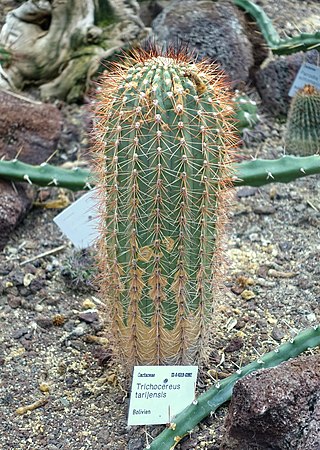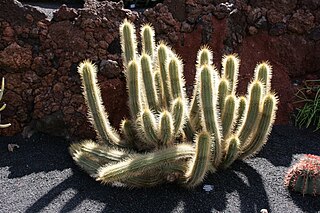
Samaipaticereus is a monotypic genus of cactus containing the sole species Samaipaticereus corroanus. It is known only from East Andean Bolivia and Peru.

Yungasocereus is a monotypic genus of cacti. Its sole species is Yungasocereus inquisivensis, native to Bolivia.

Soehrensia schickendantzii is a cactus found in northwestern Argentina in provinces of Salta and Tucumán at elevations of 1600 to 3200 meters.

Cleistocactus tominensis is a species of columnar cactus in the genus Cleistocactus, endemic to Bolivia, where it is found in forests, on cliffs, and in inter-Andean valleys at altitudes of 900 to 2,200 meters.

Soehrensia thelegona is a species of cactus in the Soehrensia genus.

Cereus phatnospermus, synonym Cereus kroenleinii, is a species of columnar cactus found in Brazil, Bolivia, and Paraguay.

Soehrensia formosa, is a species of Echinopsis found in South America. In north-western Argentina, Bolivia and northern Chile. First published in Cactac.: Handb. Kakteenk. 3: 1678 in 1959.

Lobivia bridgesii, is a species of Lobivia found in Bolivia.

Echinopsis tacaquirensis, is a species of Echinopsis found in Bolivia.

Echinopsis strigosa, is a species of Soehrensia in the cactus family. It is native to north western Argentina. It was first published in Cactaceae Syst. Init. 28: 31 in 2012.

Soehrensia tarijensis, is a species of Soehrensia, in the cactus family. It is native to Bolivia and northwestern Argentina.

Echinopsis calochlora, is a species of Echinopsis found in Bolivia.

Mirabella estevesii, synonym Cereus estevesii, is a species of columnar cactus found in Minas Gerais, Brazil. The first description was published in 2004 by Pierre Josef Braun as Cereus estevesii.

Neoraimondia herzogiana is a tree-like cactus native to Bolivia.

Cleistocactus candelilla is a species of Cleistocactus found in Bolivia.

Cleistocactus brookeae is a species of columnar cacti in the genus Cleistocactus.

Soehrensia thelegonoides is a species of Soehrensia found in Argentina.

Echinopsis marsoneri is a species of cactus from Argentina and Bolivia.

Lobivia caineana is a species of Lobivia found in Bolivia.
Leucostele tunariensis is a species of columnar cactus native to South America.






















